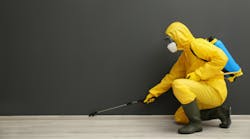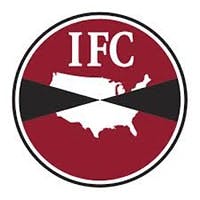Is your pest control program as effective as you’d like it to be?
In this episode, we talked with Sharon Dobesh, Director Of Technical Services, and Pamela Peckman, staff entomologist, both of Industrial Fumigant Company, about the best way to design an integrated pest management program that focuses on prevention, how sanitation works into pest control and an IPM program, as well why and how data plays such an important role in developing an IPM program.
Transcript
Food Processing: Can you tell me what's the best way to design an integrated pest management program that focuses on prevention?
Pamela Peckman: Prevention is key when it comes to pest management. And within IFC, we like to focus on an IPM pyramid principle and design our IPM programs around that.
If you can visualize a pyramid and you at the base of that pyramid, that would look like a bar that focuses in on biology of the pest that you're trying to manage. And that particular pest is going to have a unique biology that will have features that we can exploit, and that's kind of why we start with that at the base. So just think of knowledge at the base of the pyramid.
For example, knowing that many stored product insects complete their life cycle in about four weeks, means that key sanitation procedures for cleanouts need to be scheduled accordingly so that you're getting that food source emptied. If there's any eggs present or larva or pupae, you can, you know, eliminate those and kind of break that life cycle as we say.
Another example would be exploiting the habitat of rodents as they move in their surroundings. And, you know, knowing that mice use their whiskers as feelers and that they tend to move along the sides of walls, helps with strategic placement of multiple catch traps, and also bait stations so that we can intercept them in key places where they would be found searching for food, water, or shelter.
Knowing the identification of the organism is important. It helps you determine if it's a serious food safety risk, or maybe you're dealing with a target pest that's just an occasional invader and you don't really need to focus a lot of effort on the program controlling that particular pest because it just accidentally wandered into the facility.
As you move up that pyramid, you know, the next step, there's lots of additional key preventive measures that we examine to help build a successful program. And we move on to the non-chemical treatments, and that would be items such as sanitation, exclusion, trapping, temperature modifications, all those things that you can think of that are non-chemical. And this portion of the pyramid accounts for a large part of designing a good IPM program.
It’s helpful to realize that the U.S. Food and Drug Administration sets in place rules that food handling facilities must follow. These rules set minimum sanitary and processing requirements for producing safe and wholesome food, and they're known as current good manufacturing practices.
Often, you'll simply see it listed as acronym GMPs. These rules are broadly written on purpose. They don't tell a facility exactly how to implement an in-house program. That is something that facility management works on daily as systems change. So that fluctuates and it's something that they're always modifying. And pest management companies can help facilitate and fine-tune those programs so that the target pest is considered and prevented from the get-go.
About IFC
The Industrial Fumigant Company (IFC) is a national provider of pest management and sanitation solutions exclusively to the food industry. The company has worked directly with the food and commodity industries since 1937. Learn more about them on their website
In some cases, a simple change to a particular sanitation schedule or exclusion effort would help eliminate a pest feeding and harborage site. So that's why that non-chemical portion is really a big focus on IPM programs.
As you continue up that pyramid, it starts to get smaller, you're spending less time doing some of these things, but it's followed by monitoring programs, maintenance programs that the facility maintenance personnel will be involved with. And finally, that last component when we think of pest management, we always think of chemicals, but that's really one of the last tools that we tend to look at when we're setting up our pest management programs. Although it's an important part, you know, we're not going to use chemical treatments as much as we're going to focus in on other aspects of that program.
This systematic approach to managing pests in food handling facility, like I said, emphasizes non-chemical practices first, chemical tools only if necessary, and when you're managing a pest problem, you're more likely to need to implement several of those strategies at the same time, such as sanitation in conjunction with inspections and monitoring of rodent traps and pheromone traps before you might decide to proceed higher up in the pyramid with a selection of a pesticide tool. Like maybe you're gonna fog the warehouse to manage an Indianmeal moth breakout.
FP: Are there any exclusion measures IFC has seen success with for clients?
Sharon Dobesh: When you talk about exclusion measures, each facility has its own challenges and it really starts with exclusion design. That is, it considers the basic design of the facility. It starts with the construction techniques and materials.
We've seen some facilities that are 70-80 years old and may still have wood floors or wall-floor junctions that create a crack and crevice that need to have exclusionary measures taken. It really goes back to the basic design of the individual facility, as well as the environment that that facility is in because there are going to be different environmental pressures on each facility based on where it's located.
Is it near a river stream? Is it near growing fields? Or near feed lots? Its immediate environment is going to have a direct impact on that facility and those exclusionary needs can change.
We really recommend that each facility do their own inspection and document those different types of exclusionary needs, looking for deficiencies. Deficiencies can be anything from when you're going around looking at a building from the inside, you see a crack where daylight is coming through or a door that doesn't quite seal and daylight coming through either a seal or around an edge. Sometimes it’s screens over windows or louvers or even door screens that have holes in them due to damage from equipment or being not closed properly, and it just, you know, continues, that each site has its own challenges.
Some exclusion measures are for interior type design. These can be things like dock plate seals that need to be looked at on a regular basis, door seals. And these can be man doors, roll-up doors, windows, louver screening, covering different vents, and making sure that, you know, when you're using screen mesh to cover windows and vents, that you're using an appropriate size to keep out pests.
For most stored product pest insects, we recommend a screen size between a mesh number 20 and 30. That will keep out most stored product insects, or at least make it so that they have to land before they can crawl into a facility, but sometimes if you're going down to that small of mesh, you may need to check with your engineering folks and make sure that you're not going to be restricting airflow going into certain pieces of equipment or fans, and causing equipment damage. That's another one of those individualized challenges for a facility is because each facility has its own equipment, different pieces of equipment that have different needs for air intake or temperature requirements for running properly.
Exclusionary measures on the exterior of a facility can include things like those screen covers for vents and louvers. If you're on rooftops, using appropriate bird netting can keep out birds, rodents, and materials to make sure that they cannot enter different areas. You can cover your gutters in a certain way so that they don't fill up with debris, which causes a lot of decaying organic matter to be an attractant for certain insect pests, like flies.
Landscaping is another thing to think about when it comes to exclusion. We always recommend having things like trees and shrubs and any plants trimmed back at least 18-24 inches from the building at a minimum or more. You want rodent barriers, a rock barrier around your facility that has about an 18- to 24-inch band of pea gravel.
Pea gravel is usually defined as a size of rock between about a quarter and a half-inch. That way, if rodents do burrow in from the outside and they get into that area around your facility, if they tunnel through it, they can't use large rocks to prop and, you know, make a nice protected door entry for their burrows, what it does is then if they burrow in, the rock will fall in into their holes and they'll go, "Yeah, this isn't a nice place to be. I have to do a lot more work to keep my tunnels open and my facility or my burrow, you know, ready to be utilized."
And then you also must look at every opening going into and out of a facility. It could be pipes or it could be conduit. If it's going through a wall, it probably needs to be sealed. Sealing around drains and other types of pipes and things that will be coming into and out of the building so that you don't get areas where, say, organic matter is building up around the outside drains where cockroaches and other things may be attracted to those.
If it's going to be an exclusionary measure, that's going to be in an area that's going to be washed down or wet a lot, you want something that's going to be able to withstand or be moisture-resistant. You want something that's going to seal properly and stay sealed.
Some seals can be a temporary quick fix for exclusionary techniques, such as spray foam, but a lot of times we recommend spray foam being a temporary type fix because insects and rodents can chew through spray foam. And then it can also become a harborage for them if they have those tunnels, and when you go to try and treat, they have a nice hiding place.
For some exclusionary measures, we can go to the hardware store and get certain types of silicone seals or, like I said, spray foam or other things, but you want to make sure that the most important thing to make sure is that you're using the right materials for the right exclusionary situation, and not trying to put the square peg in the round hole. You want to make sure it fits, fits properly, and will do its job.
FP: Talk to me about how sanitation works into pest control and an IPM program.
PP: Good sanitation programs are key to preventing pests, but good sanitation requires time and manpower, which adds cost to the bottom line. Managing sanitation costs is tricky but cutting corners will eventually lead to pest management concerns. It's a fine balancing act with those two items, cost and sanitation.
Some of the top sanitation treatments are keeping food spills picked up, so pests don't have a food source. That sounds simple, but, this is very difficult, especially if equipment placement and access prevent routine sanitation from occurring in a food plant.
Another top sanitation solution inside a food plant is simply keeping perimeter walls clear with an 18 to 24-inch inspection space. So often when you're walking around inside a food plant, you'll see racking or pallets placed right up against the wall. And that makes it very difficult to carry out inspections just to simply see if the pest is present and it's difficult to perform, you know, routine cleaning efforts and also trapping and monitoring programs when you don't have that space clear.
We need to also remember the perimeter walls tend to be a rodent highway if you end up with rodent problems in your facility. Remember what I said earlier, they like to use their whiskers to fill the surfaces of walls and kind of follow those. Anything that can be done to view those areas and stay on top of potential pest entry is very important when it comes to sanitation.
And one other item is just having a good sanitation schedule. Make sure those difficult to clean areas are put on the schedule routinely. You have somebody that's gonna go in and do some deep cleaning and break up those life cycles so that the insects aren't building up populations in hidden areas.
As far as exterior, you heard Sharon talk quite a bit about that 18 to 24-inch perimeter around a facility. That's also part of sanitation, so you can keep the plants away from the building, you can see what's going on around the outside of the building.
Another thing as far as sanitation outside of facility is what we sometimes call the boneyard area, that place where all the old equipment that we wanna keep, but we don't really have a good storage place for. Those tend to be good spots for rodent harborage and other insect pests can become problems in those areas too, especially if there's product residue left in the old equipment.
If you're going to have a boneyard area, get it undercover and well away from the food handling facility. That way, you can access those pieces of equipment when you need them, but they're not going to be causing problems with your sanitation efforts.
FP: You mentioned pheromones and rodent trapping. What is that?
PP: Pheromones and rodent trapping are components of a good pest monitoring program. If you're not checking to see if a pest is present, then you'll miss out on early interception, and the pest problem can blow up and cause unnecessary damage.
A routine monitoring program for target pests is one of the components a pest management professional will look at closely to help prevent those pests from becoming a problem.
Pheromone traps are a great tool for monitoring key stored product insects, such as Indianmeal moths, cigarette beetles, dermestids, and flour beetles. Researchers can reproduce key pheromones that these insects emit, and they use them to attract insects to a trap, which allows the pest management professional to complete monitoring.
Some of those pheromones are sex attractants emitted by females to attract mates. They're typically sex pheromones if it's a short-lived adult, like cigarette beetles, the adults live for just a couple weeks. Same with Indian meal moths; they tend to focus in on a sex pheromone that allows them to find each other, mate, lay the eggs, and before they pass away. Anything you can do to prevent them from finding mates also helps delay or reduce the number of eggs they can lay.
The other pheromone is an aggregate pheromone, and that's just a pheromone that lets others of the same species know this is a great place to congregate in. Flour beetles, they're long-lived as adults and they tend to rely more on an aggregate pheromone.
Maintaining a pheromone monitoring program will allow for early detection of those key target pests and allow for good decision-making for possible chemical treatments. Again, if you needed to do a fogging because you feel like the stored product insect population is increasing, and that would be based on monitoring that you're actively doing.
Rodent trapping programs are a basic component of an IPM program in a food handling facility and typically consists of inter trap placements and extra placement of traps near doors and also bait stations around the perimeter of the building. The use of rodent bait inside food handling facilities is not a good practice. It's usually prohibited by most food handling facilities by their company policy due to concerns about translocation of baits. So even if the label allows it, it’s considered a no-no in food plants.
Some third-party auditors also have recommendations on spacing and placement of rodent trapping and bait devices, and that needs to be considered when you're developing a site-specific program.
One other insect monitoring tool that facilities often include in their pest management programs are insect light traps, and those require proper placement and routine monitoring. Often insects found inside these traps can help facilities reduce pest pressure.
If you've got a large number of flies, you may be using the light traps to attract the flies to the traps and kill them that way, and it definitely will indicate when increased exclusion or sanitation efforts are needed. So, it's always important to take a look at the data you're collecting from the insect light traps and make sure you don't need to fine-tune your pest management program.
FP: It sounds like data is a pretty important part to developing an IPM program. Can you speak a little bit more about that?
SD: Absolutely. Without data and without those numbers, you really have no idea where you're at. As Pamela said earlier, if you're not looking for it, you don't know if it's there or not. And so really taking that data, you know, whether you've got your traps being checked weekly, biweekly, monthly, whatever that trend is for your required facility, you know, inspections of all those traps, keeping the numbers, knowing what's been new since it was last checked, you know, whether you went from 0 insects to 20 or you've had 0 for the last 3 months, that gives you kind of a window to what's going on in the facility.
And then from there, you can use trending and look at the data. You can analyze it and it can be graphed. The data can be mapped and that can help you proactively approach your pest management.
Data can also help you determine maybe if there are local exclusion issues or sanitation issues in that area. It can help you dig further into the root cause of the problem. Is it always in where you have ingredient receiving, so are we bringing it in, in new ingredients? Is it something that is maybe where we've got some older materials? Is it a rotation issue?
You can really use that data to drill down and take a look at what's going on in those specific areas where you're finding insects or rodents even in your traps, whether it's pheromone traps, like Pamela just talked about, rodent bait stations, indoor tin cat type style mouse traps, or even ILT traps.
With ILT traps, they're great because they also catch all those occasional invaders, night flyers. If the doors happen to be open or things like that, and you get a whole bunch of night fliers in your light traps, you can tell what kind of activities are going on within your facility. And so, yeah, keeping track of numbers, knowing what pests are in those traps and actual our food pests versus those that are occasional invaders, and keeping track of that also is also very helpful.
And like I said, you can then map that, use that data to look at the bigger picture, but then also, if you get a couple of years going and you have a couple of seasons, two to three, we kind of call that trending, and you can use that trending analysis to look at, okay, do we have the same spring invaders every year or the same fall invaders every year? And if you do, you can say, okay, if they start to come in about August every fall, what do we need to be doing in June and July to prevent that from happening? And then you can start to look ahead and see, you know, what are our long-term norms for our facility, and then how do we prepare for those in advance to prevent them from becoming a problem within our facility?
At IFC we use a program called ProTrak, and you can also set up folks within your own facilities to have access to that data. They can be looking at it the same time with their technicians. IFC has 85 years of pest experience to be looking at this type of data and understand it and really helping it become part of a integrated pest management program by also using that data to set up things like escalation programs and other types of warnings which can get you in a place to be ready for that pest or to take the appropriate actions to minimize the effects of having that pest population that kind of popped up in your facility.
FP: What are some things IFC is looking into to better support clients in the future?
SD: IFC is always looking for new technologies and innovation in pest management. Things are constantly evolving, whether it's better formulations in pesticides, better trapping systems, new pheromones. And so, we always are looking into these, researching them, and working with manufacturers to be on top of what the latest technologies are.
One of the things that we're currently looking at is remote monitoring with rodent bait stations. That's one of those things that we set up and we can get electronic warnings of when rodents are in the stations, so maybe our technicians can then focus on what exclusionary measures should I be looking for, doing a proper integrated pest management inspection, educating our clients on the different pests, and just working on general IPM with the clients. It can free up their time to do a deeper dive into other areas that they didn't have time for when they were checking traps.
Also, one of the more popular tools may be mating disruptions for Indianmeal moth. And right now, there is research going on for cigarette beetles mating disruption, which we hope to be seeing come out for use later this year, as well as some other things that are in the research pipeline down the lines of mating disruption. And IFC works with manufacturers to do trials of these products in the field.
We're always looking for new things and we're always testing the products that we're using in the field. We have the ability to do some laboratory testing and, say, just do bioassays and, you know, what are we seeing? Can we test the different parameters for different insects to see what we see in a laboratory environment versus what we're seeing happen in the field in real life and, you know, help us use the products more effectively in the field?
PP: I might add one other thing, Sharon, and that's that IFC also tries to stay on top of regulatory compliance issues, and they're important to both the pest management industry and to our food processing customers. And it's tough to stay on top of what's going on, but we're super regulated and just knowing what's going on and being able to manage regulations, trying to make them better so that they're workable for our industry, or maybe we're trying to help protect one of our pest management tools.
I know in the past years we've spent a lot of effort on the fumigants and some of the fogging materials, just trying to continue to make sure use patterns are available for treatments that are really necessary in the food industry when we have very limited tools for those types of facilities.



